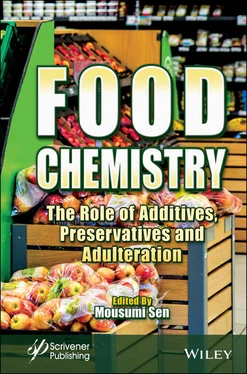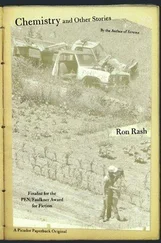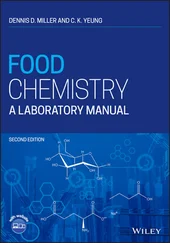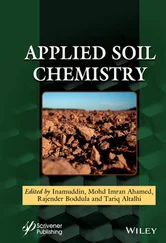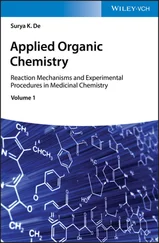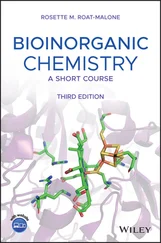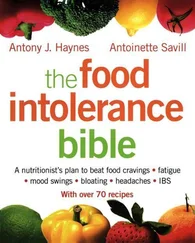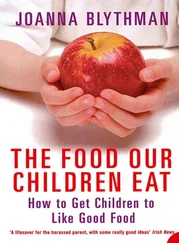Food Chemistry
Здесь есть возможность читать онлайн «Food Chemistry» — ознакомительный отрывок электронной книги совершенно бесплатно, а после прочтения отрывка купить полную версию. В некоторых случаях можно слушать аудио, скачать через торрент в формате fb2 и присутствует краткое содержание. Жанр: unrecognised, на английском языке. Описание произведения, (предисловие) а так же отзывы посетителей доступны на портале библиотеки ЛибКат.
- Название:Food Chemistry
- Автор:
- Жанр:
- Год:неизвестен
- ISBN:нет данных
- Рейтинг книги:5 / 5. Голосов: 1
-
Избранное:Добавить в избранное
- Отзывы:
-
Ваша оценка:
- 100
- 1
- 2
- 3
- 4
- 5
Food Chemistry: краткое содержание, описание и аннотация
Предлагаем к чтению аннотацию, описание, краткое содержание или предисловие (зависит от того, что написал сам автор книги «Food Chemistry»). Если вы не нашли необходимую информацию о книге — напишите в комментариях, мы постараемся отыскать её.
A unique book detailing the impact of food adulteration, food toxicity and packaging on our nutritional balance, as well as presenting and analyzing technological advancements such as the uses of green solvents with sensors for non-destructive quality evaluation of food.
Audience Food Chemistry: The Role of Additives, Preservatives and Adulteration
Food Chemistry — читать онлайн ознакомительный отрывок
Ниже представлен текст книги, разбитый по страницам. Система сохранения места последней прочитанной страницы, позволяет с удобством читать онлайн бесплатно книгу «Food Chemistry», без необходимости каждый раз заново искать на чём Вы остановились. Поставьте закладку, и сможете в любой момент перейти на страницу, на которой закончили чтение.
Интервал:
Закладка:
➢ Inhibit microbial growth is called as “microbistatic”.
➢ Irreversibly inactive microorganisms (microbicidal).
➢ Mechanically remove microorganisms.
➢ Maintain asepsis.
➢ Prevent self-decomposition of food.
➢ Inactivate food enzymes.
1.7 Preservatives
There are different types of preservatives that are best for certain products and are useful and operative against particular chemical specific changes. In things like fruit juice, cheese, bread, and dried fruit, “antimycotics” stops the growth of molds which degrades the quality of those things. Some examples are sodium and calcium propionate and sorbic acid. Another one is “antioxidants” whose butylated hydroxytoluene or (BHT) slows down the occurrence of rancidity created by oxidation in margarine, shortening, and different sets of foods consisting of fats and oils [68]. The growth of harmful bacteria in poultry, seafood, and canned foods is stopped by “antibiotics” like tetracyclines, and to keep these products moisturized, humectants and substances are used. The preservatives may get reactive toward body [70]. It can cause reactions toward in sensitive people like skin allergies including itching and rashes, difficulty in breathing, sneezing, etc.
1.7.1 Factors Affecting Preservative Efficiency
1.7.1.1 Interaction With Formulation Components
Methyl cellulose, alignates, and tragacanth that are hydrocolloids can communicate with preservatives and stop their activity. In pharmaceutical preparations, different emulgents are utilized in preparation of many applications [69]. Preservatives, emulsified oil phase, and emulgent molecules react together. The concentration of preservatives is affected by multiple factors such as the nature of oil, type of concentration of emulgent, and water ratio.
1.7.1.2 Properties of Preservatives
The dispersal of preservative should be similar/homogeneous in nature and increased solubility should be present in the bulk phase is more suitable in multi-phase system. Different chemicals like chlorobutol may get hydrolyze on storage if pH do not favor it. Preservatives do get reactive with some compounds and results in the loss of their antimicrobial property.
1.7.1.3 Effect of Containers
The preparations packed in glass containers can be anticipated to keep their preservative content if the container is closed airtight [71, 72]. Preservatives may pass through the plastic container and reacts together. Rubber is the major things which sometimes reacts with some of the preservatives but it is still used for the closures. Containers may cause defilement of pathogens.
1.7.1.4 Types of Micro-Organisms
Clostridium species, Bacillus anthracis , are some of the plant products which may have some pathogenic microorganisms from the soil. The degradation of the pharmaceutical products is caused by these soil microorganisms. Salmonella typhi is the type of pathogen that is produced from the animal source [74].
1.7.1.5 Influence of pH
The chemical stability and the activity of the preservative may get affected by the adjustment of the pH. Mostly, preservatives are less determined by the pH.
1.7.2 Factors Affecting Chemical Preservation
| Intrinsic | Extrinsic | Microbial | Processing |
| Food nutrients composition [73] | Processing temperature | Inherent resistance (vegetable cells/spores/strain/differences) | Changes in composition |
| pH/acidity [74] | atmosphere | Initial number | Changes in microbial composition |
| Buffering capacity [75] | Relative humidity | Growth rate | Changes in food microstructure |
1.7.3 Classification of Chemical Preservatives
Many chemicals are used as a chemical preservative and are added into the food. According to Food Safety and Standards Authority of India (FSSAI), chemical preservatives are classified into two classes [76–78]:
Class 1: These are the preservatives that we can usually find them in our house in kitchens. They are the preservatives that are derived from the nature. They are not harmful in nature for our body. Example: common salt, sugar, spices, vinegar, vegetable oil, honey, and wood smoke.
Class 2: These are the man-made preservatives that are chemically prepared. There are more chances that they could react with the body and causes harmful effects to the body. Example: calcium or sodium propionate, sorbic acid or its sodium potassium and calcium salt, and acidulants.
1.7.4 Types of Chemical Preservatives
These preservatives are used in foods either as direct additives or are themselves developed during processes such as fermentation or decomposition [79, 80]. There are certain preservatives which can be used.
| Natural | Sugar, Salt |
| Weak organic acid (Acidulants) | Acetic acid, lactic acid, sorbic acid and its salt, benzoic acid and its salt, propionic acid and its salt, malic, tartaric, citric, and ascorbic acid |
| Inorganic Salt | Nitrites and nitrates, chlorine, iodine, hydrogen peroxide phosphoric acid, and borax |
| Gaseous | Sulfur dioxide and sulfites, carbon dioxide and ethylene and propylene oxides |
| Other | Antioxidants, oils, and spices |
1.7.5 Natural Chemical Preservatives
From ancient times, the salt and sugars are used as chemical preservatives. They are the regular part of our diet. The salt causes the food dehydration by drying out the water and tying up from the tissues of the food. It also ionizes yielding chlorine ion and interfere with the action of proteolytic enzymes which is harmful to the microorganisms. Similarly, sugar is also a part of our regular diet. It also produces the condition of high osmotic pressure that are unfavorable. Natural preservatives are the part of ancient method to save food from decaying. It delays the growth of unwanted substances like bacteria in the food for some time. They have different properties like antioxidative, antifungal, and antimicrobial which helps in the delay and prevention of the growth of unwanted substances [81–86].
1 1. Salt (Sodium Chloride, NaCl): It can be found in everyone’s kitchen. It is considered as one of the best natural preservative. It helps in the preservation of non-vegetarian food like meat, chicken, and some vegetables, too. Different unwanted substances sometimes breed on the food in the aqueous medium like bacteria and yeast, and they feed and degrade the food making it unfit to eat so salt helps to prevent this spoilage by the help of the process osmosis in which it dehydrates the microbes.
2 2. Sugar (Sucrose, C12H22O11): It is also a natural preservative which can be found in everyone’s kitchen as the major role of it is to act as a sweetener. Sugar also helps to prevent the spoilage by the help of the process osmosis in which it dehydrates the microbes and bacteria, and yeast cannot breed and reproduce there.
3 3. Vinegar: Vinegar is also a natural preservative which everyone has in their kitchen helps in the preservation of meat and poultry food items. It also elevates the taste and antimicrobial property is also present in it. The fermentation of sugar is the process which helps in the formation of the vinegar. Vinegar has acetic acid in it which destroys the microbes and stops the food degradation. We have a very common example, i.e., “Pickling” which acts as a preservative.
Читать дальшеИнтервал:
Закладка:
Похожие книги на «Food Chemistry»
Представляем Вашему вниманию похожие книги на «Food Chemistry» списком для выбора. Мы отобрали схожую по названию и смыслу литературу в надежде предоставить читателям больше вариантов отыскать новые, интересные, ещё непрочитанные произведения.
Обсуждение, отзывы о книге «Food Chemistry» и просто собственные мнения читателей. Оставьте ваши комментарии, напишите, что Вы думаете о произведении, его смысле или главных героях. Укажите что конкретно понравилось, а что нет, и почему Вы так считаете.
